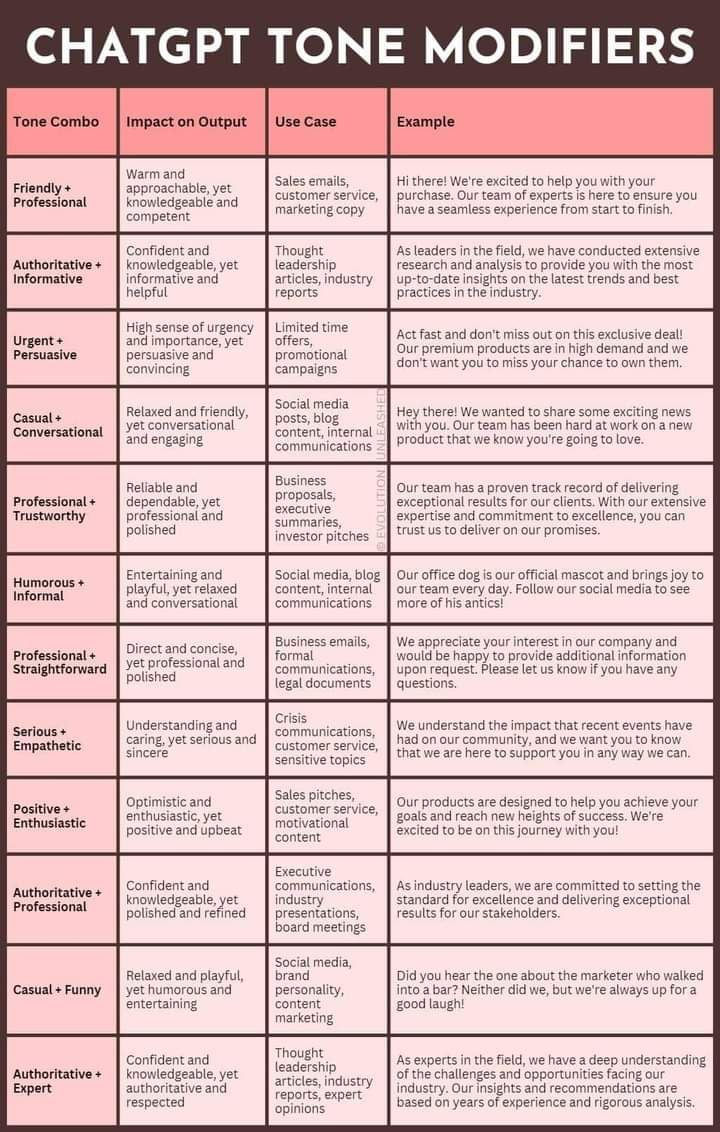Which SEO techniques has your business utilized in the first part of 2023? Want to see if you’ve been keeping up with the latest SEO trends?
The team from SMB Services share their key SEO trends from 2023 in this infographic.

Emmanuel Fonte | Music | Art | Leadership
If music be the food of love, play on. Emmanuel Fonte website is about music, art, real estate, architecture, design and decor. Occasionally, I talk about my other passion, hockey.
Which SEO techniques has your business utilized in the first part of 2023? Want to see if you’ve been keeping up with the latest SEO trends?
The team from SMB Services share their key SEO trends from 2023 in this infographic.

Are you using generative AI tools in your digital marketing process?
The latest wave of AI apps have provided a window into a world of new possibilities, though when you actually get down to it, their capacity, at least at this stage, is somewhat limited, in terms of quality, consistency, etc.

Are you looking for ways to improve your ChatGPT content? Want to learn how to guide the output you receive using tone modifiers?
You’ll find a complete guide to ChatGPT tone modifiers in this infographic.

Are you looking to build a stronger online presence for your small business? Want to learn the essential components that make up a successful online strategy?
The team from Brafton shares its online tips in this infographic.

Looking for ways to improve your site’s SEO performance?
This will help. The team from SEMRush recently published their latest SEO fundamentals checklist, which covers all the key elements that you need to keep in mind to improve the “crawlability” of your website.
The full checklist covers 44 key points to consider, from keyword research to more technical elements, which will give you some clear guidance as to where your focus should be when working on your site.
Worth a look. You can also get more SEO info on the SEMRush blog.


Another great guest post from Mary Aspen Richardson maryaspen.richardson@gmail.com
In an era where technology bridges gaps and distances, the dynamics of teamwork have transcended traditional office spaces. Remote collaboration has become an essential facet of modern work culture, enabling teams to unite from different corners of the world to achieve shared goals. As organizations increasingly adopt remote environments, mastering the art of remote collaboration becomes imperative for teamwork in virtual environments and achieving success.
In the realm of virtual collaboration, the power of connection reigns supreme. Building a strong team is not merely about sharing tasks; it’s about establishing meaningful connections among team members that transcend the digital realm. Effective communication, open channels, and regular check-ins create a sense of camaraderie, despite physical distances, fostering an environment where collaboration flows seamlessly, and creativity thrives.
Creating a collaborative virtual culture is an art that requires deliberate effort. To foster teamwork in remote environments, leaders must cultivate a culture that encourages trust, respect, and mutual support. Embracing inclusivity and acknowledging diverse perspectives can lead to innovative problem-solving and heightened morale. This inclusivity enhances creativity and contributes to a sense of belonging, where each team member feels valued and empowered to contribute their best ideas. By fostering an environment where everyone’s voice is heard and respected, leaders lay the foundation for a dynamic virtual workspace that thrives on collaboration and synergy.
Many tools empower remote teams to collaborate seamlessly. Technology offers various resources to enhance teamwork, from video conferencing to project management platforms. Choosing the right tools and optimizing their usage is essential for efficient communication, task delegation, and progress tracking.
In order to make it easy for visitors to reach out and engage with the team, consider incorporating a callback widget into your virtual collaboration platforms. Using a callback widget allows users to initiate real-time conversations and seek assistance without prolonged email exchanges or waiting for responses. It utilizes the power of instant connectivity to bridge communication gaps, ensuring that questions are promptly addressed and that cooperation remains fluid.
Furthermore, integrating artificial intelligence and machine learning has brought intelligent assistants and automation that streamline routine tasks, freeing up valuable time for team members to focus on high-impact activities. These technologies can help analyze data trends, suggest optimal communication channels, and even anticipate project bottlenecks, enhancing the overall efficiency of remote collaboration.
Clear and concise communication lies at the heart of successful remote collaboration. Regular updates, transparent information sharing, and active listening are crucial to effective virtual teamwork. Overcoming communication barriers ensures everyone remains aligned with objectives and informed about ongoing projects.
Fostering an environment where questions are encouraged and clarity is prioritized can prevent misunderstandings and enhance cooperation. Regular video conferences and virtual “coffee chats” provide opportunities to interact in a more informal setting, helping to build stronger connections and promoting open dialogue.
In addition, utilizing various communication channels, such as instant messaging platforms and project management tools, enables real-time discussions and document sharing, reducing delays and keeping the team’s momentum steady. Effective communication streamlines tasks and nurtures a sense of unity among team members, making the environment feel just as connected as a traditional office space.
Virtual environments often span across different time zones, requiring teams to embrace flexibility. Understanding and accommodating varying work hours and personal commitments can strengthen bonds. Creating a shared schedule that respects everyone’s availability and preferences promotes fairness and harmony.
Embracing time zone differences can offer unexpected benefits. With team members working around the clock, projects can progress even during “off” hours, leading to faster turnaround times. This continuous workflow can foster a sense of productivity and accomplishment as team members contribute their expertise when they are most energized and focused. Additionally, the global nature of remote collaboration enriches the team with diverse perspectives, enhancing creativity and innovation in problem-solving.
Incorporating tools like world clocks and time zone converters can further facilitate coordination, helping team members visualize each other’s work hours and enabling efficient scheduling of meetings and tasks. By recognizing and adapting to virtual teamwork’s temporal diversity, teams can capitalize on the advantages of remote collaboration.
Remote collaboration isn’t without its challenges. Technical glitches, miscommunications, and feelings of isolation can hinder teamwork. Embracing a proactive problem-solving approach and encouraging open discussions help address these obstacles. Sharing best practices and collectively finding solutions contribute to a more resilient remote team.
Fostering a culture of continuous improvement is paramount in overcoming hurdles that arise in a virtual workplace. Regularly assessing processes, soliciting feedback from team members, and conducting brainstorming sessions can uncover innovative ways to tackle complex challenges. By viewing obstacles as opportunities for growth, remote teams can transform setbacks into stepping stones toward greater cohesion and effectiveness.
Acknowledging accomplishments, no matter how small, is essential in nurturing a positive remote work culture. Virtual celebrations, shout-outs, and recognition of individual contributions create a sense of unity and boost team morale. Taking time to celebrate milestones reinforces the value of teamwork and motivates team members to strive for excellence.
As the landscape of remote collaboration continues to evolve, so too must our strategies for fostering teamwork in virtual environments. Embracing continuous learning, staying updated with technological advancements, and remaining attuned to the changing needs of remote teams will ensure sustained success in the art of virtual collaboration.
Embracing a culture of experimentation can invigorate remote teamwork. Encouraging team members to explore new ways of interacting, utilizing emerging tools, and testing innovative communication approaches can lead to breakthroughs in collaboration. This willingness to adapt and experiment enhances the team’s efficiency and nurtures a sense of excitement and empowerment among remote team members. Just as a garden thrives with attentive care and novel gardening techniques, a virtual team flourishes when nurtured through adaptive strategies and a commitment to innovation.
In the symphony of remote collaboration, each team member plays a vital role, contributing their unique notes to create harmonious outcomes. The art of fostering teamwork in virtual environments is a skill that demands dedication, adaptability, and a deep understanding of the nuances of remote work dynamics. By connecting, communicating, and embracing the challenges and triumphs of remote work, teams can compose a melody of success that resonates across geographical boundaries.
keyword: teamwork in virtual environments
Meta Description: Unlock the secrets to effective remote collaboration and ways to foster teamwork in virtual environments.
https://www.pexels.com/photo/people-on-a-video-call-4226140/
Is your website failing to generate the results you hoped for? Want to learn the most common website design mistakes small businesses make?
The team from Studio1Design shares its website mistakes to avoid in this infographic.
Here are a few that make their list:
Check out the infographic for more.


Another great guest post from natalie@homeownerbliss.info
If you’re looking to stay ahead of the competition and drive business growth, integrating artificial intelligence (AI) into your existing operations might just be the answer. AI can improve operational efficiency, streamline workflows, and provide valuable insights to help you make more informed decisions. But where do you start? In this article, we’ll explore some tips for successfully integrating AI into your business.
When it comes to adopting new technology, it’s important to approach it with a positive attitude and mindset. Embracing AI as an opportunity rather than a threat can go a long way in making the transition smoother. It’s important to recognize that AI is here to assist you and make your life easier, not replace you. By adopting this mindset, you’ll be more open to exploring the possibilities that AI can bring to your business.
Before implementing AI into your business, it’s important to have a solid foundation of data. Developing a data strategy can help you understand what data you have, what data you need, and how you can best use it to make effective business decisions. A well-defined data strategy can also help you identify areas where AI can be most beneficial. For example, if you’re looking to improve customer engagement, you may want to focus on collecting and analyzing customer data to better understand their needs and preferences.
One of the biggest challenges with AI is ensuring that the algorithms and data used aren’t biased. Biased data can lead to inaccurate results and unfair treatment of certain groups. It’s important to monitor and address any potential biases in the data and algorithms used in your AI systems. This can be done by regularly reviewing the data and algorithms and making necessary adjustments to ensure fairness and accuracy.
A CDP can provide a more unified view of customer insights by collecting data from multiple sources and combining it into a single customer profile. This helps businesses better understand their customers’ behaviors, preferences, and needs and create more personalized experiences. Integrating AI with a CDP also allows for predictive analytics to anticipate customers’ future behaviors and needs.
Transparency is key when it comes to developing and using AI in your business. Customers want to know how their data is being used and what decisions are being made based on that data. By prioritizing transparency in the development and use of AI, you can build trust with your customers and make them feel more comfortable sharing their data with you. This can be done by providing clear explanations of how your AI systems work, what data is being used, and how decisions are being made.
Integrating AI into your existing workflows can be a major change for your employees, and it’s important to provide them with the necessary training and resources to adapt. Thorough training can help your employees better understand how AI works and how it can benefit them in their roles. By involving your employees in the AI implementation process and providing them with the necessary training, you can make them more likely to embrace the new technology and use it effectively in their day-to-day work.
If you’re looking to improve operational efficiencies and streamline workflows, choosing the right automation and AI platform is crucial. It’s important to choose a platform that aligns with your business needs and goals and has the necessary features and integrations to make it easy to use and implement. With so many options available, this page deserves a look to explore some of the most popular automation and AI platforms for businesses.
In conclusion, integrating AI into your business can be a game-changer when it comes to improving operational efficiency, streamlining workflows, and making more informed decisions. By embracing AI as an opportunity, using a customer data platform, choosing the right platform, etc., you can successfully integrate AI into your existing operations and take your business to the next level.
Image via Pexels

Guest post from Mary Aspen Richardson maryaspen.richardson@gmail.com
Most business owners who aren’t proficient with website design and development need help dodging the dreaded pitfalls of SEO. We all know how crucial it is to have our websites work flawlessly and attract more visitors. But beware! There are some sneaky common SEO mistakes lurking around that can hinder your website’s visibility and organic traffic. Fear not, though, for we will guide you through these treacherous waters and equip you with the right strategies to steer clear of these mistakes. So, let’s dive right in!
Unfortunately, neglecting keyword research is like going on a treasure hunt without a map. You may stumble upon some hidden gems by chance, but the odds are not in your favor. Keyword research is the backbone of any effective SEO strategy. It helps you understand what your target audience is searching for and enables you to align your content with their needs.
To embark on this keyword adventure, you need the right tools. Google Keyword Planner, SEMrush, and Moz Keyword Explorer are just a few examples of the arsenal at your disposal. Take the time to explore these tools and dig deep into the data they provide. Look for keywords with decent search volume and low competition, and sprinkle them naturally throughout your content.
But remember, don’t go overboard with keyword stuffing. Google’s algorithms are smarter than ever and can sniff out unnatural keyword usage from a mile away. Write for humans first, and the search engine gods will reward you.
Ignoring on-page optimization is like setting sail without adjusting your sails or plotting your course. On-page optimization is the compass that guides search engines to navigate your website effectively. Start by optimizing your meta tags, titles, and descriptions. Craft compelling meta descriptions that entice users to click through to your website. Use header tags (H1, H2, etc.) to structure your content and guide readers through your page like a seasoned tour guide.
Don’t forget about your images! Give them proper names and add descriptive alt tags. This way, search engines will understand what your images are all about, even if they can’t see them. Oh, and a little secret: search engines love it when you link internally and externally. So, be a generous host and guide your visitors to relevant resources on your website and other reputable sites.
Now it’s time to peek under the hood. Technical SEO focuses on the behind-the-scenes aspects of your website that affect its performance and visibility. Start by ensuring your website is fast and responsive. Slow-loading websites are like sluggish turtles, and nobody wants to wait for a page to load for more than a few seconds.
Next, make sure your website is mobile-friendly and embraces the beauty of responsive design. With the rise of smartphones, more and more users are accessing the internet through their pocket companions. Proper URL structure and canonical tags are also essential for technical SEO. They help search engines understand the hierarchy and organization of your content, ensuring your website is a well-structured and easily navigable vessel. And don’t forget to generate XML sitemaps and submit them to search engines. Consider it your website’s personal invitation to be explored and indexed.
Content is king, and without it, your organic traffic will suffer. Therefore, you should take a moment to review the articles on your website. Neglecting quality content is one of the most common SEO mistakes, and it’s like serving a half-baked cake at a birthday party. It leaves a bad taste in everyone’s mouth.
Creating high-quality content is the secret sauce to winning the hearts of both users and search engines. Your content should be unique, valuable, and relevant to your target audience. Be the problem-solver they need, the expert they can trust, and the friend they turn to for advice. Format your content properly with catchy headings, subheadings, and paragraphs. Break up the text with bullet points, images, and videos to keep your readers engaged and scrolling for more.
Remember, using relevant keywords within your content is important, but don’t force them in like a square peg in a round hole. Let them flow naturally as if they were part of a conversation. Your readers will appreciate the authenticity, and search engines will give you a thumbs up.
In the online world, link-building is like networking with the right crowd. Except, instead of connecting to people, you connect to websites with strong domain authority. It helps your site build authority, credibility, and, most importantly, visibility.
Backlinks are the currency of the internet. They act as votes of confidence for your website, signaling to search engines that you are a trusted source. To set up backlinks for your website, you must first identify reputable and relevant websites in your industry. Reach out to them, engage with their content, and build relationships. Guest blogging is another fantastic way to showcase your expertise and gain valuable backlinks. Be the life of the party and offer to write guest posts that provide value to their audience.
And don’t forget the power of social media! Sharing your content, engaging with others, and fostering a community around your brand will help you master social media. The more people share and link to your content, the merrier.
But beware, my friends, of the dark side of link building. Stay away from black hat SEO techniques and spammy link practices. These shortcuts may lead to quick wins, but search engines are wise to their tricks, and you’ll end up walking the plank of penalties.
When delving into the realm of SEO, it’s essential to confront the harsh truths that lie beneath the surface. There are a few facts you should know that will help you navigate the often-unpredictable landscape of search engine optimization. Firstly, SEO is not a magic potion that guarantees overnight success. It requires time, effort, and a continuous learning curve. Secondly, search engines are constantly evolving, with algorithms that are shrouded in secrecy. What works today may not work tomorrow. Thirdly, competition is fierce. You’re not the only one vying for that coveted top spot in search results. It takes diligent research, strategic planning, and staying ahead of the curve to stand out from the crowd. Lastly, SEO is not a one-time fix. It’s an ongoing process that demands constant monitoring, tweaking, and adapting to the ever-changing digital landscape.
You have now armed yourself with the knowledge and strategies to avoid the treacherous traps of common SEO mistakes. Remember, it is an ongoing journey, and it requires continuous learning and adaptation.
By conducting thorough keyword research, embracing on-page optimization, mastering technical SEO, delivering quality content, and building strong links, you will chart a course to success in the vast sea of the internet. Thankfully, now you can set sail with confidence, navigate wisely, avoid common SEO mistakes, and watch as your website rises in visibility and conquers the search engine rankings. May the winds of SEO fortune be forever in your favor!
Meta Description: Discover the most common SEO mistakes and learn effective strategies to avoid them, improving your website’s visibility and ranking on search engines.
Image used:
Copyright © 2016-2024All Rights Reserved
Powered by Wordpress Web Design on the Genesis Framework